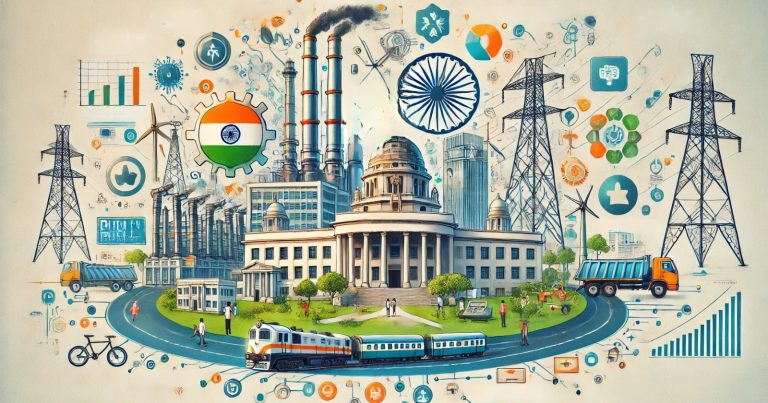The public sector is the portion of the economy owned and managed by the government. The role of public sector in determining the economic scenario of a nation. Public sector enterprises and services are central to providing social welfare, financial stability, and development. In countries like India, the public sector plays a role in economic growth, development, and infrastructure. By providing vital services and resources, the public sector fills gaps created by private businesses, particularly in industries essential to the national interest. In this article, we shall discuss the various aspects of the role of the public sector and its contribution to economic development.
What is Public Sector?
The public sector is the portion of the economy owned by the government. It comprises state-owned businesses, government agencies, and institutions run by public funds. They offer services to the public and are responsible for meeting the needs of society in sectors where private businesses may not be effective or efficient. The function of the public sector covers a wide range of industries, ranging from education, healthcare, and transportation to energy and defense.
Classification of Public Sector
The public sector can be divided into central public sector enterprises (CPSEs) and state public sector enterprises (SPSEs). Together, they play a vital role in their citizens’ promotion and socio-economic development by providing individual and public goods and services.
- Central Public Sector Enterprises (CPSEs): These are operated and owned by the central government. CPSEs are pan-India, involve more than one service, and provide various resources. Such institutions include Indian Oil Corporation, Bharat Heavy Electricals Limited (BHEL), and Coal India Limited.
- State Public Sector Enterprises (SPSEs): The state governments own and manage these. SPSEs are also called regional target industries and contribute to building state-wide infrastructure. e.g. Maharashtra State Electricity Distribution Company Limited (MSEDCL) and Gujarat State Fertilizers and Chemicals Limited (GSFC).
Role of Public Sector
The role of public sector is multi-faceted, covering a wide range of functions and responsibilities. It plays so many roles that it ensures economic stability, delivers essential services, provides social protection, creates jobs, regulates the private sector to promote fairness and protects the public interest. Here are its major roles in the economy:
Economic Stability and Growth
By controlling key industries like energy, transportation, and banking, the public sector also contributes to the economy’s stability. Bank of India and even banks in the public sector provide stable finance and enable credits to persons and firms. This provides stability, which reduces the risk of economic shocks and allows for sustainable long-term growth.
Providing Public Goods and Services
Some PSUs offer vital services such as healthcare, education, sanitation, and public transport, catering to the mass population. The government usually subsidizes these services so everyone, including poorer groups, can afford them. The population is enabled to thrive through these public sector services.
Social Welfare and Equity
Given that the public sector contributes to social welfare and contests for social equity in society, it is clear that it is vitally important. It finances programs like the National Rural Employment Guarantee Act (NREGA), which provides jobs to marginalized groups. The public sector achieves a more equal and just society through these initiatives.
Job Creation
Thousands of jobs are created through public sector enterprises, which help low unemployment. Such jobs cover a wide spectrum from working in offices to skilled labor positions, providing many people with consistent employment and financial stability. The public sector hires in diverse fields, helping the nation’s economy be stable and grow.
Regulating and Monitoring Private Sector
Private businesses will have some degree of regulation placed on them by the public sector to ensure fairness and consumer protection. They create rules and policies to ensure that firms do not exploit customers or damage the economy. These regulations encourage competition, create a level playing field, and hold private companies accountable to the public and the environment.
Objective of Public Sector
Public sector goals are subservient to national development and public welfare. The following are the main objectives of the public sector:
- Economic Development: The potential for positive economic impact is significant in public sector activities with complex purposes. It is supposed to create and maintain infrastructure like roads, ports and railway tracks, which are essential for the economy. This investment helps set the stage for sustainable economic growth in the years to come.
- Public Welfare: Any organization, system, or company that establishes lawful work in the public sector aims to improve the well-being of citizens. They care about the well-being of the people, such as health care, education and health, housing, among other public services. These services also reduce inequality and help ensure social well-being among the population.
- National Security: Public sector enterprises are pivotal in maintaining national security in the defense and aerospace sectors. The reason is that their industry provides the resources, technologies, and workforce to protect the country. The country remains secure and prepared to counter any threat by doing so.
- Jobs Are Created Meaning: Employment generation is an important public sector goal. Government-owned enterprises directly and indirectly employ millions and thereby reduce unemployment. These jobs have a stable income and influence the nation’s economic advancement.
- Reducing Regional Disparity: The public sector significantly reduces regional imbalances by investing in backward areas. Hence, they are often established in backward regions for industrialization and development. This lifts these areas, bringing local jobs and raising living standards.
Importance of Public Sector
The importance of public sector is a key part of national development. The electricity sector, for instance, is vital for construction, industry, and equitable access to necessary goods and services (which is why it forms part of every prosperous country).
- Social Welfare Program: The public sector provides free or very low-cost basic needs such as hospitals and education, enabling even the poorest members of society to access opportunities, all the more so in a country like India, which has social inequality.
- National Security: A strong public sector is important in securing a nation, especially in defense, intelligence, and policing services. The national security contribution of the public sector is invaluable in ensuring the sovereignty and safety of the nation.
- Investment in Strategic Sectors: The government sector tends to drive investment in sectors that are not profitable in the short term but are vital for long-term economic growth, e.g., renewable energy or basic research.
- Economic Growth and Stability: Public sector institutions in the form of roads, railways, energy distribution, etc, are the fulcrum of a nation’s infrastructure. Such sectors are essential for the normal working of the economy. It would have gnawing infrastructure gaps, meaning slower economic development without the public sector.
- Encouraging Industrialization: Public sector companies have played a crucial role in industrialization. The government invests in those industries that involve high capital and long-term planning, like steel, coal, and oil.
Public Sector Challenges
The public sector is vital to a nation’s development but is plagued by several challenges that can undermine its efficiency. As a result of these challenges, public sector enterprises cannot render optimal services, and to realize their full potential, they are burdened with inefficiency, political interference, inadequate funds, and older technologies.
- Inefficiency and Bureaucracy: Bureaucratic red tape creates inefficiency in public sector organizations, along with delayed decision-making and lack of competition. This hold-up of services doesn’t allow swift action to serve the public needs. Lack of accountability makes it harder to streamline processes and implement effective changes.
- Political Interference: Political interference normally affects the working of public sector enterprises. Politicians can manipulate these decisions, leading to ineffective management and corruption. It undermines the ability of public institutions to function well and deliver goods and services, diminishing their overall effectiveness and the public’s trust in them.
- Budgetary Constraints: Although financed by taxes, public sector organizations typically operate under fiscal restrictions. The budget limits their investment in infrastructure and the improvement of services. Therefore, public services might be underfunded, resulting in inferior quality and unfilled public needs.
- Technological Constraints: Public sector institutions tend to fall behind in using new technologies due to infrastructure obsolescence, a dearth of expertise, or a shortage of funds. This leads to inefficiency and reduced quality of services against private sector equivalents. Such institutions must adapt and evolve to meet the needs of the digital age or risk becoming obsolete.
- Competitive Nature with Private Sector: Public sector firms face intense rivalry against the private sector, which is often superior in services (quality and efficiency). The ability of the private sector to adapt and innovate is usually an added advantage in satisfying customer needs on time, thus leaving the public sector behind in some sectors.
Public Sector Undertaking Reforms
The demand for public sector undertaking (PSU) reforms to make them competitive and efficient has gained strong ground in recent years. It has been furthering the privatization policy of some PSUs to improve market-driven practices and performance. In such context, the emphasis is on privatization and disinvestment, primarily undertaken to curb inefficiency and create a competitive environment. The reforms also sought to improve the corporate governance of the organizations.
The government has consciously attempted to increase autonomy among PSUs to make them more efficient with less bureaucratic control, no micromanagement and freedom to make independent decisions. This decentralization allows for more efficient governance and a quicker response to market demands. Public-private partnerships (PPPs) have also become popular as reform measures. Such partnerships leverage the best of both worlds, the public and private sectors, for the more effective and higher-performance delivery of services.
Role of Public Sector FAQs
1. What is the public sector role in Indian economy?
The public sector’s role in Indian economy is critical in propelling economic growth, generating employment, offering social welfare services, and promoting industries of national importance.
2. What was the public sector role before to 1991?
Before 1991, the public sector dominated India’s industrialization and concentrated on energy, transport, and steel industries. After the 1991 reforms, privatization and liberalization resulted, lessening its dominance.
3. What is the difference between public and private sector?
The government owns and controls the public sector, whereas private individuals or companies own and control the private sector. Public sector enterprises are concerned with public welfare, whereas private sector companies are concerned with profit-making.
4. What are the problems of public sector enterprises?
Public sector enterprises have problems like inefficiency, political interference, financial constraints, obsolescence of technology, and competition from the private sector.
5. What is the public sector’s role in development?
The public sector’s role in development involves encouraging industrialization, supplying public goods, generating employment, and maintaining economic stability and social equity.


